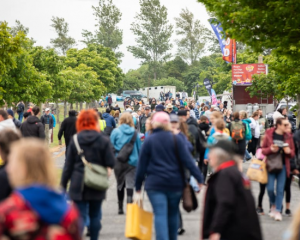
Pastoral farmers are re-evaluating their farming systems and exploring land-use diversification options as they brace for strict environmental regulations, volatile markets and the impact of climate change on production.
More than 30 people attended a workshop on land-use diversification opportunities for pastoral farmers in the Upper Taieri catchment.
Farmer and The Whole Story founder Becks Smith, of Gimmerburn, facilitated the event in Ranfurly.
The project was supported by the Upper Taieri Wai catchment group and explored "blue-sky thinking" for land-use diversification opportunities for farmers in the upper catchment.
The workshop was in response to farmers in the catchment telling the project team the diversification opportunities they were interested in.
Mrs Smith said pastoral farmers recognised they were likely to have to re-evaluate their farming system for reasons including increasingly stringent environmental regulations, volatile markets and climate change impacts on production.

The changes could reduce revenue, so diversification provided opportunities for alternative sources of income, helped reduce environmental impacts and supported succession planning, she said.
Plant & Food Research new crops agronomist Bruce Smallfield, of Dunedin, spoke about crop options available for the Upper Taieri.
The crops researched were fruits, nuts, essential oils, herb and medicinal, ornamental and arable seed, Dr Smallfield said.
Each crop was assessed for what was required to grow and process it and its available market.
Dr Smallfield produced lists of crops suitable for growing in the area.
The fruit crops were blackcurrant, elder, gooseberry, pear, plum, quince, raspberry, redcurrant and sour cherry.

The nut crops were hazelnut, pine nuts, sweet chestnuts and walnut, he said.
He doubted almond crops would survive the frosts in the Maniototo.
More than 20 essential oil crops, from angelica to wormwood, were identified.
"Essential oils offers an opportunity for a small, high-value industry."
The nearly 40 suitable herb and medicinal crops identified included saffron crocus.
"Saffron crocus is for someone who wants to spend their Easter on their hands and knees."

"You’d need to be a professional seed producer to think about arable seed production," he said.
Information was also available on former novel crop trials of arnica, camomile, coriander and saffron in the Maniototo.
A trial of arnica at Styx Creek in the Maniototo, at 720m altitude, produced the highest flower yields and best survival rates of plants in the trials.
The main supply of arnica flowers was traditionally from the wild in Romania and Spain.
However, the wild arnica population in Europe was decreasing due to habitat loss and exploitation.
Research showed there was a market for 120 tonnes of arnica flowers from New Zealand.

"It’s a prized delicacy in Japan, " Dr Smallfield said.
Shoro occurs and fruits naturally in pine forests without irrigation in Naseby.
Demand for the fungi had increased as the wild supply declined in the northern hemisphere.
Markets for the fungi had grown as consumers sought substitutes for meat, Dr Smallfield said.
Work was required to identify the market value potential of the crop, he said.
The first cultivation of the fungi was in a pine plantation in Nelson in 2001.

Irrigation could improve reliability of the crop growing as the fruiting season was highly dependent on soil temperatures and autumn rainfall.
The fungi was not proven at a large commercial scale and research on the crop was limited.
Tourism Central Otago destination head Antz Longman spoke about tourism diversification opportunities available to farmers in the region.
The key attractions bringing tourists to the region were the Otago Central Rail Trail and the Central Otago Touring Route between Queenstown and Dunedin.
Tourists wanted "boutique experiences which were true to place", Mr Longman said.
People visiting the region wanted to celebrate the night skies, engage with the environment and learn where their food came from.

However, if they accommodated more than six people, a resource consent was needed.
Some tourism operators, such as those offering 4WD experiences or guided walks, were looking for unique locations to work.
Tourism Central Otago could link farmers with operators so they could get a financial gain without running a business, Mr Longman said.
The first topic of discussion at the workshop was a decision-support tool, created to help farmers explore a range of options on possible diversification options.
Team members who designed the spreadsheet were independent researcher Liz Dooley and Massey University rural valuation lecturer Iona McCarthy, both of Palmerston North.
Dr Dooley said the tool ranks the alternative options under set criteria such as requirements of capital, cashflow, compliance and labour and the farmers expected enjoyment and motivation for each option.

Farmers presenting at the workshop included Canterbury deer farmer Duncan Humm on his diversification to solar farming and South Otago dairy farmer Sandra Campbell’s journey of planting native trees.
Stories on both farmers will feature in next week’s Southern Rural Life.
The government funded the diversification project through the Department of Conservation and the Ministry of Business, Innovation and Employment programme Our Land and Water.
Department of Conservation freshwater ranger Chris Kavazos, of Alexandra, said he was leading the department’s national Ngā Awa restoration project for the 5700sq km Taieri catchment.
The project aims to enhance biodiversity, ecosystem functioning and climate change resistance.
"They are the three issues we are trying to tackle," Mr Kavozos said.













